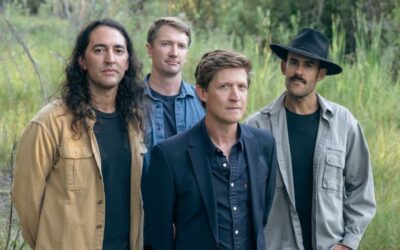DJ Mark Farina made a name for himself as one the most important selectors, combining hard-hitting house sets with deep and downtempo music from around the world under the name “Mushroom Jazz.”
Consistently voted as one of the top DJs in the world by the global music press, Farina’s taste-making skills continue to turn the heads of both seasoned dance music veterans and newcomers alike.
Farina spoke with KHOL in advance of his headlining set at The Mangy Moose on Friday, June 23.
The following interview transcript has been edited for clarity and brevity. This conversation was recorded on Wednesday, May 17.
JACK CATLIN/KHOL: Your first love is house music but in 1992, you created this entirely different lane of “mushroom jazz” in San Francisco that now has an entire world of its own. What was the initial inspiration behind “mushroom jazz” and what made you want to offer this combination of sounds as an alternative option?
MARK FARINA: I started working at Gramophone Records in Chicago at about the same time. We started buying a lot of the European acid jazz records that were coming out on Talkin’ Loud and the Acid Jazz label. And then there were only some American releases at the time but a lot of French acid jazz and we were lucky because we were working at the store. We could have access to listening to all that stuff because there were definitely limited copies. It wasn’t like now where you could just buy stuff endlessly. A shipment would come in on a Monday and there would be five copies of this French import, an acid jazz record, like a Mo Wax record. If you’re there working, you could get that. So it would stem from getting those records.
I liked a lot of the early hip-hop from New York. We had friends that would eventually send us Bobbito and Stretch mixtapes. So I liked a lot of hip-hop, but if it was a little too gangster-ish or if it was dealing with subject matter that I wasn’t into like guns and things, I’d still like listening to it, but I didn’t always want to play that stuff, so I’d play the instrumentals. I started mixing hip-hop instrumentals with acid jazz, and then it also stemmed from the club I was working at in Chicago called Shelter. They opened a “B Room,” a new room called the Paramount Room, which was this room with a big wooden ceiling and sofas and stuff. It was just like a lounge, you know, with lamps and things. The main room was a full-on nightclub.
And at that same time, we had been going to New York to go record shopping on trips starting around 1989. We noticed that clubs in New York would have a house room and then there’d be a hip-hop room and then a dancehall room, three different sounds going on in the same club. There’d be different rooms with different stuff. But in Chicago at that time, it would be normal to have two rooms. At Shelter, there was the main room and then there was this other room called the Boiler Room. But it was just house in both all the time, basically, you know, house or disco. A lot of the venues were like that. If it had two rooms, it was just house.
So instead of competing with the main room, I decided to start playing these other records where you don’t have to build a dance floor or worry about that. And that’s how mushroom jazz started playing — this mixture of early acid jazz with funk and soul bits and then hip-hop instrumentals. That gave us chill-out music in Chicago, because in Chicago at that time you couldn’t really play below 120 or 125 beats per minute. When I listen to old tapes now from the Chicago days, they’re more in the 127, almost 130 bpm range. All that kind of stuff was quite fast, so you couldn’t really have a dance floor in Chicago for downtempo.
When I went to San Francisco, there was definitely more of an open-mindedness to different BPMs on the dance floor than in Chicago. So that’s where the mushroom jazz night came about after I’d already been doing the mix tapes. It came about in San Francisco that people would actually dance to downtempo whereas in Chicago it was a pretty hard thing to do. Even when we would try and throw a mushroom jazz night in Chicago [it didn’t work]. Like if you got below 120 BPM, people would be like “Later!” and walk out. So that’s kind of how it evolved from there. Whereas in San Francisco became more of a proper dance floor weekly, and that went on for like three years and it would be 500 or 600 people every Monday dancing to 100 beats per minute kind of stuff. Maybe you only get up to like 110 BPM as a max.
KHOL: I love this about you and I’m sure many of your fans do. It’s like you can listen to Mark Farina House mix all night and go crazy, and then when you’re coming down, you want to listen to the mushroom jazz. So you kind of flex two different distinctive creative muscles. How do you balance both of those different styles and what does each of them do for you from a creative standpoint?
FARINA: I feel fortunate to have played another genre because that’s opened up people being able to hear different tempos. And different times of the day and different venues call for different music. If it’s a sunset thing and you’re outdoors you’re going to play something different than in a dark club. So it’s nice to have different elements. And I think mushroom jazz was always generally slower in that 95 beats per minute range. And then over time, especially with a lot of the nu-disco kind of stuff that’s been coming out, it sort of bridged the gap for a while.
It was hard to find mid-tempo stuff between house and the slow stuff, and you could find a lot more once the digital era started, like in the later 2000s when a lot of nu-disco labels started popping up. So now I could go from that slower 95 beats per minute and kind of blend slowly up to house, you know, as opposed to doing a cut and going right into house, like going from 100 beats per minute to 125.
If you’re playing just a two-hour slot and you’re in between house people you’re not going to deviate much from whatever tempo is going on around you. But sometimes, when you’re playing all night you could start slow and bring it up and down. I find that being in a club as opposed to an outdoor kind of thing creates different vibes that you can change tempos and different audiences at different speeds.
Listen above for KHOL’s full conversation with Mark Farina.





